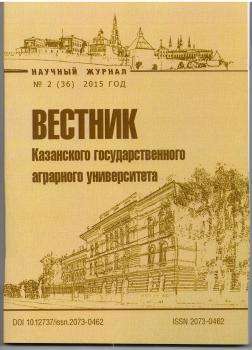Russian Federation
Russian Federation
Russian Federation
CSCSTI 68.03
The solutions of many problems of agricultural engineering are expressed through special functions. In particular, such problems include the problem of determining the displacement trajectories and the falling time of the hingedly working units of agricultural machines, when the suspension axis moves horizontally at a certain speed. Such working device include: a stacker valve, falling after release from the shock, a beam of transverse rakes, that falls after the release of the roll and others. The solution of such problems is to determine the motion time of a physical pendulum to a given angular position, which is expressed in terms of elliptic integrals. And although elliptic integrals are a well-studied class of functions, in many cases an approximate solution of similar problems in elementary functions is quite sufficient both from the point of view of practical application and convenience of use. In addition, this approach makes it possible to determine the approximate law of motion of a physical pendulum in an explicit form, which makes it easier to set and solve problems of optimizing the operating modes and parameters of the above-mentioned working units. By estimating the integral, such an approximate law of motion of a mathematical pendulum was obtained. Its accuracy is sufficient for engineering practice. The obtained formula for the oscillation period of a pendulum with a large amplitude makes it possible to determine the falling time of the hinged working units of agricultural machines with high accuracy.
working units, trajectories of motion, physical pendulum, large amplitude oscillations, oscillation period, approximately harmonic oscillations.
Задача определения периода колебаний маятника привлекла внимание исследователей, прежде всего, в связи с использованием его как средства измерения времени. Вопрос о зависимости периода колебаний маятника от максимального угла отклонения его от положения равновесия был поставлен уже в мемуаре Х. Гюйгенса «Маятниковые часы». Он отмечал, «можно, например, показать, что время, в течение которого маятник проходит четверть окружности, относится ко времени падения по очень малой дуге, как 34:29. Это различие периодов колебаний ни в коем случае не объясняется сопротивлением воздуха, как думают некоторые, но вытекает из самой природы движения и свойств круга» [1, c. 19]. И хотя Х. Гюгенс дает достаточно точное значение времени движения, с ошибкой всего лишь 0,8%, он не приводит аналитического решения. Полное аналитическое решение этой задачи было получено при помощи эллиптического интеграла лишь в 1734 году П. Эльвиусом [1]. Исследованию зависимости периода колебаний маятника от их амплитуды посвящен ряд работ современных исследователей [2 – 6].
Решение многих задач сельскохозяйственного машиностроения невозможно без применения специальных функций. Одной из довольно распространенных задач такого типа является задача об определении времени падения шарнирно закрепленных рабочих органов сельскохозяйственных машин и траекторий их перемещения, когда ось подвески движется горизонтально со скоростью νм. К таким рабочим органам относятся клапан копнителя, падающий после освобождения от копны, брус поперечных грабель, который падает после освобождения валка и т.д. [7]. Решение этих задач сводится к определению времени движения физического маятника до заданного углового положения, которое выражается через эллиптические интегралы.
Несмотря на то, что эллиптические интегралы являются хорошо изученным классом специальных функций, во многих случаях приближенное решение подобных задач в элементарных функциях является вполне достаточным как с точки зрения практического применения, так и удобства использования. Кроме того, такой подход позволяет определить приближенный закон движения физического маятника в явном виде, что позволяет проще ставить и решать задачи оптимизации режимов работы и параметров упомянутых выше рабочих органов.
Поэтому цель данного исследования – найти приближенный закон движения физического маятника и определить период свободных колебаний для значительных углов его отклонения от положения равновесия, с точностью достаточной для решения задач сельскохозяйственного машиностроения.
1. Gyuygens Kh. Tri memuara po mekhanike. [Three memoirs on mechanics]. / Kh. Gyuygens. - M.: AN SSSR, 1951. - P. 377.
2. Kochetkov A.V., Chelpanov I.B., Fedotov P.V. Determination of the period of large oscillations of a pendulum in elementary functions. [Opredelenie perioda bolshikh kolebaniy mayatnika v elementarnykh funktsiyakh]. / A.V. Kochetkov, I.B. Chelpanov, P.V. Fedotov // Izmeritelnaya tekhnika. - Measuring Technology. - 2016. - №6. - P. 39-41.
3. Talalay V.V., Kochetkov A.V., Fedotov P.V., Talalay M.V. Opredelenie perioda bolshikh kolebaniy mayatnika (do 90°). // Internet-zhurnal “NAUKOVEDENIE”. (Determination of the period of large oscillations of the pendulum (up to 90 °). // Internet journal “Naukovedenie”). Volume 8, № 5 (2016). Abailable at: http://naukovedenie.ru/PDF/73TVN516.pdf (free).
4. P. Amore, M. Cervantes Valdovinos, G. Ornelas, and S. Zamudio Barajas. The nonlinear pendulum: formulas for the large amplitude period. Revista Mexicana De Fisica E 53 (1) 2007, P. 106-111.
5. A. Belendez. C. Pascual. D.I. Mendez. T. Belendez and C. Neipp. Exact solution for the nonlinear pendulum. Revista Brasileira de Ensino de Fisica. v. 29. n. 4, 2007, P. 645-648.
6. Ileana Toma New periodic LEM solutions for the nonlinear pendulum. Rev. Roum. Sci. Techn. - Mec. Appl., TOME 53, № 2, 2008, - Bucarest, p. 135-146.
7. Dolgov I.A., Vasilev G.K. Matematicheskie metody v zemledelcheskoy mekhanike. [Mathematical methods in agricultural mechanics]. / I.A. Dolgov, G.K. Vasilev. - M.: “Mashinostroenie”, 1967. - P. 204.
8. Magnus K. Kolebaniya: vvedenie v issledovanie kolebatelnykh sistem. Per. s nem. [Oscillations: an introduction to the study of oscillatory systems. Translated from German]. / K. Magnus. - M.: Mir, 1982. - P. 304, illustrated.
9. Spravochnik po spetsialnym funktsiyam s formulami, grafikami i tablitsami. [Handbook of special functions with formulas, graphs and tables]. / - M.: Nauka, 1979. - P. 832, illustrated.





